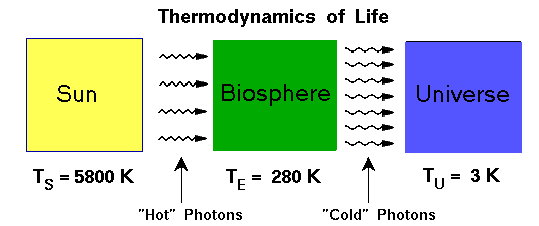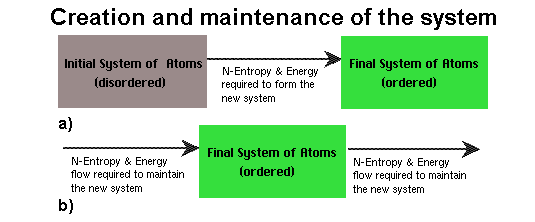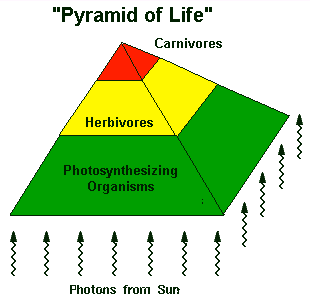|
 Life on Earth - Flow of Energy and
Entropy
Life on Earth - Flow of Energy and
Entropy
Copyright 1992-2014, Digital Recordings, All Rights Reserved
PDF version (34 kB)
Abstract
Darwin's Theory of Evolution [4,5,7] explains how and why life evolved
[9,10]. However, some aspects of this theory are still not clear
[4,5,7,8,12,14,15]. According to Darwin, natural selection allows the strongest
and most fit species to survive in a particular environment [9,10]. What
remains to be answered is how these complex systems (organisms) were first
formed and how they maintain their presence on Earth. It is obvious that the
entropy of the Biosphere is decreasing continuously (at least it was before the
industrial revolution and deforestation).This means that the matter involved in
the formation of the Biosphere is getting more and more organized (less
random). It was pointed out by many that life seems to defy the II Law of
Thermodynamics, which states, that entropy of any system should be
increasing [4-7]. Several attempts were made to explain this striking
phenomenon on the basis of the "Theory of Complexity", which suggest, that
there are undiscovered laws of nature which are responsible for "Self-
Organization" of organisms and the Biosphere [4-7]. This paper explains
the principles responsible for the formation and maintenance of life on Earth
and shows that there is no violation of the II Law of Thermodynamics in the
case of organisms and the Biosphere.
It is generally accepted that the Biosphere is getting more complex and
organized or less random and that global entropy of the Biosphere is
decreasing, due to increased organization. This seems like a paradox
which contradicts the II Law of Thermodynamics, which states, that the
entropy of a system tends to get higher as time progresses because
disorganization increases.

The above statement is true for a closed system which is not interacting with the environment. However, the Biosphere is an open thermodynamic subsystem, which can exchange matter, energy and entropy with the environment (defined here as the rest of the Universe). One can by 'manipulation' from outside the system decrease the entropy in the subsystem. This is not a violation of the II Law of Thermodynamics since the entropy of the total system (subsystem and outside environment) will increase as stated by the II Law of Thermodynamics. During the production of clothing , cars, chemical compounds etc., the entropy of the system is decreased because the components are organized. However this is done at the expense of the manufacturing system (including people) whose entropy will increase during this process. In a refrigerator entropy of the air is decreased by lowering the temperature. This occurs at the expense of increased entropy of the environment and the refrigerator. Therefore, one subsystem is able to decrease the entropy of an other subsystem. However the entropy of the total system will increase with time and the total system will follow the II Law of Thermodynamics. In other words the entropy of one system can be manipulated via another system. The Sun as a Source of Negative Entropy
The Biosphere is defined here as all of the matter which is used to
'build' living organisms. Part of this matter is in the living organisms
and part in the 'recycling' stage. The environment is defined here as
all the other matter on Earth and in the Universe, including radiation.
In order to get more organized, the Biosphere requires an influx of
'negative entropy' (first mentioned by E. Schrodinger - ref [2]) from
external sources (entropy is extracted from the Biosphere) in order to
conform to the II Law of Thermodynamics. What are the sources of this
'negative entropy' ? The Sun is the major source of the energy on Earth.
Another source of 'natural energy' is geothermal energy. However, the
total balance of energy for the Biosphere is on average zero for energy
from the Sun, the same amount of energy is absorbed as is released, and
is also on average zero for the Geothermal energy from Earth, when the
Biosphere is in a steady-state condition.

What is the source of negative entropy ? The Sun's energy is highly organized and carried by photons. Our Biosphere absorbs this energy and then releases it back to the Universe -the global balance of energy is zero (Fig.2). However, energy released to the environment is in the form of electromagnetic radiation, which is on average at longer wavelengths than the absorbed photons (Fig.1 and 2). The black body radiation of the Sun (5800 K), which is absorbed by the Biosphere has a much higher temperature than the black body radiation from the Biosphere and Earth (280 K) flowing to the Universe (3 K) (Fig.2). The explanation is that the Biosphere does not accumulate energy when it is in steady-state condition, but it accumulates negative entropy and increases in organization. This is the difference between the entropy of absorbed radiation and the emitted radiation at longer wavelengths of photons (Fig.1 and 2). On the basis of this theory quantitative calculations of the total "negative entropy" balance on Earth, can be made. The Energy Balance for Earth The solar constant for Earth is sc = 1360 W / m2 = 1.36 GW / km2 [1]. Assuming that the radius of the Earth is RE = 6,366 km then the total rate of energy flow (power) on Earth is equal to:
Some of this energy accumulates in the Biosphere, but most of it is radiated back to space in the form of electromagnetic radiation.
The temperature of the Sun's surface is TS
where: RS The Sun is the major energy source for Earth. Geothermal energy is comparatively minor, since ice caps formed on the Earth's Poles where the average intensity of the Sun's radiation is low. "Circle of Life"
The visible surface of the Sun contributes energy and entropy which
reaches the Earth. If one assumes that photons are propagating radially
from the Sun, then only a small circle on the Sun's surface will
contribute to energy and entropy flow from the Sun. The radius of this
circle RL can be calculated from the geometrical considerations (Fig.1):
Result (3) shows that energy and entropy flow which sustains Life on
Earth is due to black body radiation from the equivalent 'Circle of Life'
of radius RL Entropy Balance for Earth
The entropy of photon gas in a black body cavity of Kelvin temperature
T and volume V can be calculated from the formula [1]:
where:
kB = 1.38066
Rate of entropy flow d
If one assumes that the Earth's surface radiates energy as a black body
at temperature TE then the rate of entropy flow d
Approximated flow of the entropy (maximum possible value), which is responsible for the formation and sustenance of Life on Earth is equal to (from eq. (5) and eq. 6)):
This influx of the negative entropy (information - ref [20]) estimated in equation (7) is the magic "Life Force" responsible for the organization of organic and non-organic matter into more complex, living things (Fig.2). There is no magic self-organizing force as implied by some researchers working in the area of the Theory of Complexity [4,5,6,7]. The organizing flow of negative entropy develops more complex structures from organic and non-organic matter and these structures in turn compete with each other, due to limited resources in terms of space, matter, energy and entropy. Natural selection as described by Darwin's theory is one part of this equation [9,10]. Another is the negative entropy-based structuring of matter. For example : A child builds structures from LEGO blocks (Theory of negative entropy-based structuring of matter), a second child chooses the best designs and throws away other structures (Environment and Natural Selection - Darwin), a third child destroys all structures (II Law of Thermodynamics). Depending on the rate at which each child works different configurations (Biosphere) will be seen in the box with LEGO toys (Earth). "Equations of Life"
In the "growing period" of evolution of life on Earth the time-averaged
change of energy (EB) and entropy(
During this initial stage of Evolution, only part of the Sun's radiation was interacting with the Biosphere, since only part of the Earth's surface was covered by terrestrial and aquatic plants. Over time the living part of the Biosphere became larger, more complex and more efficient in the extraction of energy and negative entropy from photon gas flowing from the Sun. In the "steady-state period" when evolution of life on Earth reaches it's limit the change of energy and entropy of the Biosphere should be:
The Biosphere's etropy ( d
The negative entropy input ( d Creation and Maintenance of the Organized System of Atoms
On Fig.3 a) creation of the particular system of atoms is illustrated.
In order to form a particular Final System from the Initial System,
certain minimum N-Entropy (Information- ref [20]) and Energy input will
be required. Depending on the efficiency of the process (which depends
on many parameters) expenditure of N-Entropy and Energy in a particular
process will be larger than the theoretical minimum. Establishing these
requirements is not an easy task and for complex systems could be
determined via experimental rather than theoretical estimations. The
final System could be anything - living organism, building, farm, city,
car, TV set, etc.

On Fig.3 b) maintenance of the particular system of atoms is illustrated. In order to maintain a particular Final System, certain minimum N-Entropy (Information - ref [20]) and Energy flow will be required. Depending on the efficiency of the process (which depends on many parameters) N-Entropy and Energy flow in a particular process will be larger than the theoretical minimum. Establishing these requirements is not an easy task and for complex systems could be determined via experimental rather than theoretical estimations. Global estimation of the required N-Entropy and Energy flow could be estimated for a particular subsystem on Earth or for whole Earth and compared with available N-Entropy and Energy flow for a particular region. This could be of help in better agriculture, aquaculture, urban, etc. planning. There are rigid physical constraints imposed by the N-Entropy and Energy flow to Earth which cannot be violated. "Pyramid of Life" Biological systems have evolved in such a way that they efficiently extract negative entropy from the black body, photon radiation of the Sun. Life on Earth is organized in the form of a pyramid of interdependence (Fig.4). At the base of this pyramid are species which use photosynthetic processes [11,12,13,14,15] to synthesize basic organic compounds. Negative entropy and energy flows from the Sun and is converted into highly-structured organic compounds such as carbohydrates [11,12,13,14,15]. The entropy of the material used in the process of photosynthesis is decreased due to negative-entropy-driven structuring of this matter. Without photosynthesizing organisms the Biosphere could not exist. Animals use the Sun's energy and negative entropy indirectly and are therefore dependant on photo-synthesizing species. During digesting and utilization of organic food, energy and negative entropy is extracted in order to build and maintain higher - level organism. Digested food has a much lower energy content and much higher entropy as is returned to the environment. Therefore all species use energy and negative entropy flowing from the Sun to Earth.

Natural Selection helps to select species which are most effective in survival and can efficiently utilize energy and negative entropy. The Sun provides the energy and entropy to produce basic organic compounds. A change in the environment, man-made or natural, can change the "Pyramid of Life". This could result in the elimination of the species at the apex of the food chain because they are dependent on the lower levels of the pyramid (Fig.4). After any interference the equilibrium of the "Pyramid of Life" could change and lead to the extinction of some species. This could be the fate of mankind, due to man-made pollution and changes in the ecosystem. Management of entropy resources must be taken under serious consideration. Sexual recombination of genetic material is an effective way to protect genetic information stored in DNA and RNA. This is one way to protect the genetic information from an increase of entropy according to the II Law of Thermodynamics. The rate of aging and length of life span of a particular species could be programmed into the genetic code to optimize survival of a species [3]. This would explain why there are vast differences in the life spans of different species. Their life span was optimized during evolution to insure survival of a species in a particular niche of the ecosystem. Conclusions This paper explains the missing component which is responsible for the creation of life on Earth. The concept of negative entropy (first introduced by E. Schrodinger - ref [2]) or information (Shannon - ref [20]) and the ability of the Biosphere to effectively extract it from the Sun's radiation is very important for life on Earth. This concept was not included in the original work of Darwin [9,10], which explained the natural selection of species, but did not explain the origin and maintenance of Life on Earth. Presented theory is based on known laws of Physics and shows that life does not violate these laws as has been suggested [4,5,6,7]. This paper provides the ground for further explaration of the phenomenon of life on Earth or other planets and provides a new outlook on the evolution of complex negative-entropy-driven systems. In author's opinion there are profound implications of this work for the maintenance of natural resources (one of which is entropy). Also author belives that the human interactions with the Environment and Biosphere have to be carefully evaluated and considered in order to maintain the delicate balance needed for life to exist on Earth [16,17,18,19].
References
Terms of Use | Return Policy | Privacy Policy
No part of the information provided on this www page may be reproduced for any purpose, in any form, without prior written approval.
|

 = ( 4
= ( 4 
 dEB / dt
dEB / dt  t
t  0 (energy was stored in the Biosphere)
0 (energy was stored in the Biosphere) 0 (entropy was decreasing in the Biosphere)
0 (entropy was decreasing in the Biosphere)